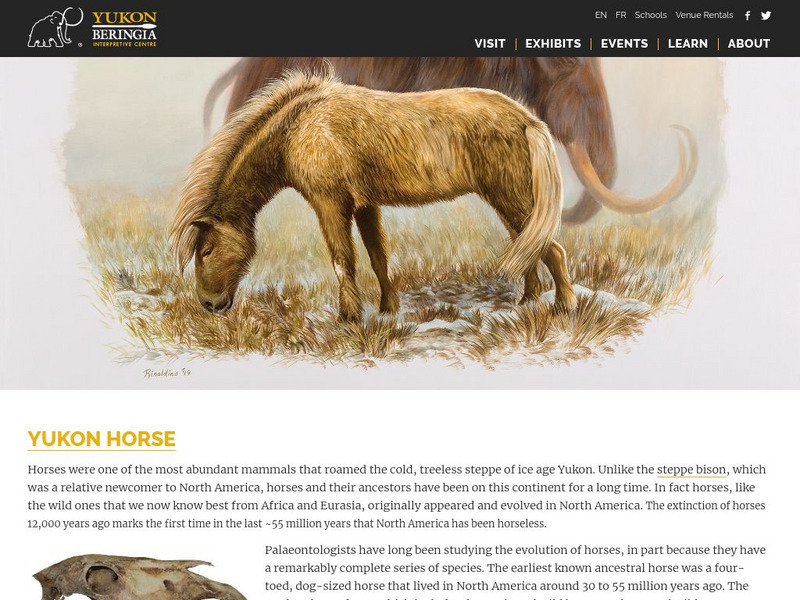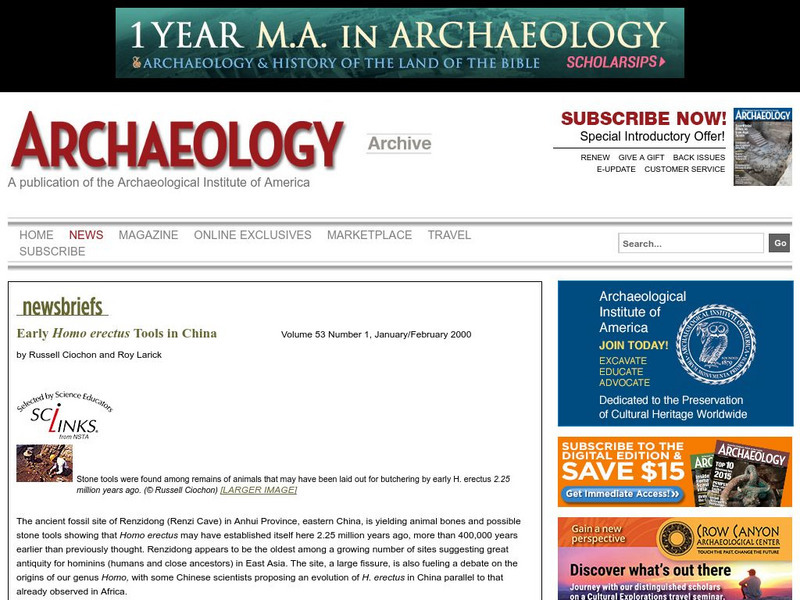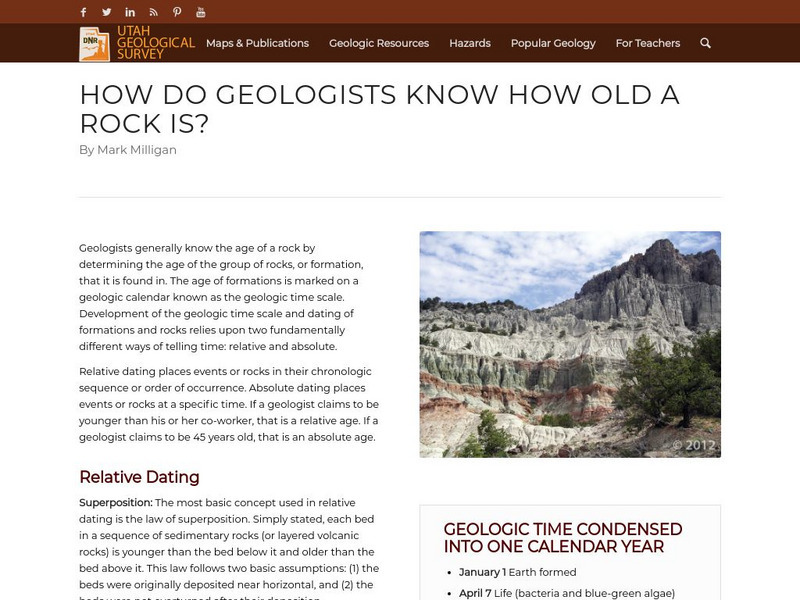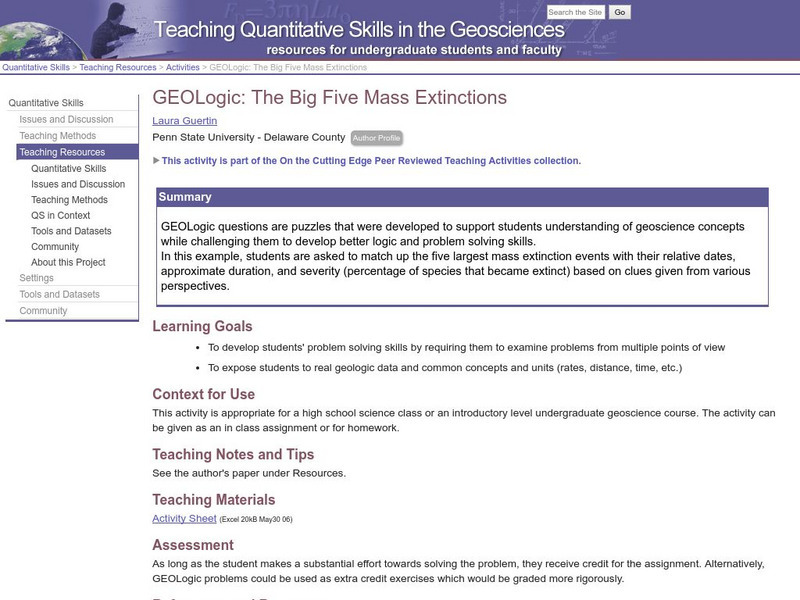Other
Yukon Beringia Interpretive Centre: Research: Yukon Horse
Uncover discoveries from the past by learning about the prehistoric Yukon horse. Includes information about the time period, physical characteristics, fossil specimens, feeding habits, and habitat.
Other
Yukon Beringia Interpretive Centre: Research: Saiga Antelope
Uncover discoveries from the past by learning about the prehistoric North American saiga. Includes information about the time period, physical characteristics, fossil specimens, feeding habits, and habitat.
Archaeological Institute of America
Early Homo Erectus Tools in China
An article which describes a fossil site in eastern China where evidence has been found that Home erectus may have been active in eastern China some 400,000 years earlier than scientists believed. The authors also summarize the debate...
Other
Prehistoric Planet: Rock Layers: Timeline of Life on Earth
Offers an easy to understand explanation of the earth's layers and the fossils we find in each layer. It explains how these are interpreted by scientists to represent the evolution of animal and plant life through the geological eras.
Other
Yukon Beringia Interpretive Centre: Research: Yukon's Camels
Uncover discoveries from the past by learning about the prehistoric camels of the Yukon and Alaska. Includes information about the time period, physical characteristics, fossil specimens, feeding habits, and habitat.
Other
Yukon Beringia Interpretive Centre: Research: Beringian Lion
Uncover discoveries from the past by learning about the prehistoric Beringian lion and the American lion that evolved from it. Includes information about the time period, physical characteristics, fossil specimens, feeding habits, and...
Other
Utah Geological Survey: How Do Geologists Know How Old a Rock Is?
Geologists generally know the age of a rock by determining the age of the group of rocks, or formation, that it is found in. The age of formations is marked on a geologic calendar known as the geologic time scale. Development of the...
Science Education Resource Center at Carleton College
Serc: Geo Logic: The Big Five Mass Extinctions
Using GEOLogic puzzles, students are asked to match the five largest mass extinction events with their relative dates, approximate duration, and severity based on clues given from various perspectives.
Soft Schools
Soft Schools: Evolution Quiz Ii
Take an interactive quiz over evolution. After completing the quiz, check your score, and then revisit any incorrect question for further review.
The Wonder of Science
The Wonder of Science: 4 Ess1 1: Evidence From Rock Layers
Work samples, phenomena, assessment templates, and videos that directly address standard 4-ESS1-1: evidence from rock layers.
Alabama Learning Exchange
Alex: Dig It!
Children will enjoy learning about dinosaurs through the use of technology, research, hands-on activities, discussions, and written and oral presentations. This unit will help students to collaborate as a group and manage their own time.
Utah STEM Foundation
Utah Stem Action Center: Idle Effects
Young scholars will collect data on how much time they and their families spend idling their cars and the cost.
Curated OER
The Virtual Fossil Museum: Fossils Across Geological Time and Evolution
Picture of the fossil Leanchoilia superlata from the Phylum Arthropoda recovered from Burgess Shale.
Curated OER
Agi: Evolution and the Fossil Record
The American Geological Institute has done a great job defining and explaining evolution in this online booklet. Darwin, fossils, natural selection, and change over time are some of the concepts that are covered. Make sure to see the...
Curated OER
Agi: Evolution and the Fossil Record
The American Geological Institute has done a great job defining and explaining evolution in this online booklet. Darwin, fossils, natural selection, and change over time are some of the concepts that are covered. Make sure to see the...
Other
Evolution: Evidence From Living Organisms
By examining fossils, scientists have collected evidence that supports the theory that species changed over time. As you read this article, study this evidence and critically evaluate whether it indicates that species may have arisen by...
Australian Broadcasting Corporation
Australian Broadcasting Corporation: Walking With Dinosaurs: Fact File: Quetzalcoatlus
A brief description of the quetzacoatlus, "the largest flying creature of all time," which lived during the Late Cretaceous period over 65 million years ago. Find fast facts about this animal's size and fossil location, as well as...
University of Texas at Austin
University of Texas: Human Environmental Interactions [Pdf]
Inspired by Hemispheres' 2004 Teachers' Summer Institute, People and Place: Human-Geographic Relations, this curriculum unit was designed to address human adaptation to and modification of the environment. How have humans adjusted to...
Curated OER
Etc: Maps Etc: Migrations of Early Native Peoples, 1889
A sketch map of North America from 1888 showing the probable lines of migration and distribution of the American Tribes, including the Esquimaux (Eskimo), West Coast Tribes, Tinne, Algonquin Tribes, and the Alleghans and Toltecans, based...












